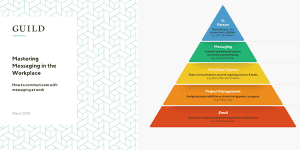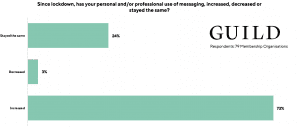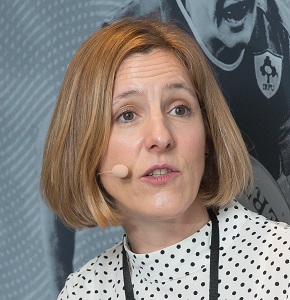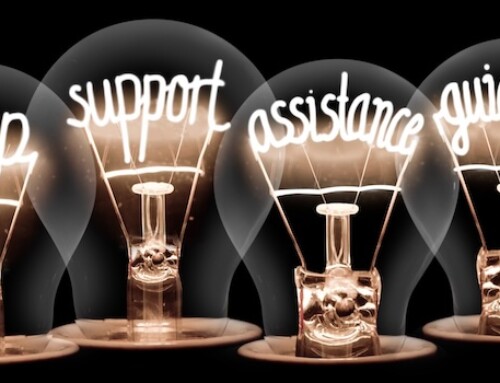Video conferencing, messaging and workflow collaboration technology has exploded.
This accelerated digital transformation of operations and communications is certainly great news for the tech companies. Zoom Communication Inc experienced a massive rise in share price and Microsoft reported that Monthly Active Users (MAUs) of its Teams product spiked by 12 million in one week in March 2020.
Remote technologies bring operational efficiencies and cost savings to membership organisations and will continue to do so, whatever things look like in a post-lockdown world.
What about this super-growth medium – Messaging?
Messaging growth is outpacing social network growth.
Consumer communication is dominated by messaging apps such as WhatsApp, Facebook Messenger and WeChat. In 2019, an estimated 2.52 billion people worldwide (87% of smartphone users) were using a mobile messaging app at least once per month.[1]
By 2020, the four largest mobile messaging apps (WhatsApp, Facebook Messenger, WeChat and Viber) had more than 6 billion users in total, surpassing the 4.5 billion users on the four largest social networks (Facebook, Twitter, Instagram and LinkedIn)[2].
Facebook Inc. owned WhatsApp has over two billion users,[3] making it the most popular consumer messaging app worldwide. In 2019 WhatsApp usage outranked Facebook Messenger (1.3 billion users), and WeChat, (>1 billion users).
89% of internet users aged 16 to 64 use chat or messaging apps on their mobile phone, and that half their time on mobile devices is spent on social and communication apps.[4]
Messaging takes many forms in the professional world – whether that’s workflow collaboration tools like MS Teams and Slack, project management tools like Asana or Jira and professional messaging/community platforms like Guild or Hospify.
Like MS Teams, and Slack, Guild, has experienced phenomenal growth – a 120% increase in total messages were sent on the professional messaging platform for the three months after 23 March, compared to the prior period.
The CIPD use professional messaging for member groups such as their ‘HR Leaders: Covid-19 support’ group.
Messaging is quick, it’s intimate and people seem to really like it. But it needs to be integrated into wider business governance and communications strategies.
Membership organisations need to be clear on what they want to achieve from messaging technologies. Replacing another member communications channel or community, and not having a clearly defined purpose will simply add to the noise and member frustration.
The dangers of WhatsApp and the ‘social media problem’
WhatsApp and other consumer messaging apps are not the answer.
In February 2020 Privsec Report, a website produced by the Data Protection World Forum, quoted
David Naylor, Partner at law firm Wiggin and a specialist in media and technology about consumer messaging apps and GDPR compliance:
“It is difficult to see how WhatsApp could claim to be fully GDPR compliant and it is against WhatsApp’s own terms of use to use it for work purposes. Businesses are taking risks if they allow employees to use consumer messaging apps which operate completely outside their governance, making it impossible to protect company data or comply with their own data protection obligations.”
When comes to business and professional use, for example, messaging members or even using WhatsApp to chat internally in your organisation, it is wise to double-check WhatsApp’s terms of service, as these state:
“You will not use (or assist others in using) our Services in ways that: (f) involve any non-personal use of our Services unless otherwise authorized by us.”
Facebook and LinkedIn Pages are subject to platform algorithms and the need for constant engagement on posts to retain visibility. Membership organisations need to have a significant Facebook and LinkedIn advertising budget to ensure that carefully crafted posts continue to reach members.
When using Facebook and LinkedIn, even for private Groups, membership organisations surrender community control and ownership as well as data value. Every user click, like, comment or message provides data for behavioural targeting and ads that interrupt the user experience.
Understandably, most membership organisation simply haven’t had the time to step back and deal with their WhatsApp and social media challenges.
Navigating the opportunities and risks of messaging
Pre Covid19 Guild commissioned research to help understand why messaging strategies were the exceptions, rather than the norm.
Messaging feels like social media did 10 years ago. Very few organisations have clearly defined how messaging can deliver efficiencies or value for them. Membership organisations are not alone in this.
Based on a series of interviews with internal communications, digital transformation and corporate governance experts, ‘Mastering Messaging in the Workplace’ covers messaging data, frameworks, models and clear definitions, opportunities and use cases for messaging. The report also outlines security, privacy and compliance risk associated with the rise of unsanctioned consumer messaging apps for professional purposes and how to mitigate this.
Guild’s founder and CEO Ashley Friedlein ran a webinar with MemberWise in May 2020. ‘Messaging: how to harness this fast-growth digital medium to engage with members’
A recording of the presentation is here: https://guild.co/blog/membership-organisations-harness-messaging/
MemberWise ran polls during the webinar. 73% of membership organisations who attended said that they had increased their personal and professional use of messaging apps since lockdown measures had begun. https://guild.co/blog/membership-organisations-messaging-survey/
67% of attendees said using messaging to engage member groups and create communities was likely to have the biggest impact for them.
Membership organisations and associations who are successfully using messaging
There are a growing number of Membership organisations and associations, including the CIPD, PPA, CIWM and IPIA using messaging to build groups and communities to connect and engage with their members.
The IPIA have set up ‘The Sourcing Bridge‘ messaging group for members and buyers in the print industry to connect
What next for member organisations?
Given the seemingly unstoppable growth of messaging, the speed of digital transformation and the appetite amongst membership organisations to get closer to their members, now feels like a good time to explore the opportunities.
Our ‘message’ is:
Read up, test the platforms and identify what members will really value from this exciting medium.
[1] https://www.emarketer.com/content/global-messaging-apps-2019
[2] Estimates based on publicly available data.
[3] https://about.fb.com/news/2020/02/two-billion-users/
[4] https://wearesocial.com/digital-2020
 Guild is a professional messaging app that is as easy to use as an everyday messaging app but built just for work. Guild is GDPR-compliant and advertising free. Download the free ‘Mastering Messaging in the Workplace’ report here.
Guild is a professional messaging app that is as easy to use as an everyday messaging app but built just for work. Guild is GDPR-compliant and advertising free. Download the free ‘Mastering Messaging in the Workplace’ report here.














Leave A Comment